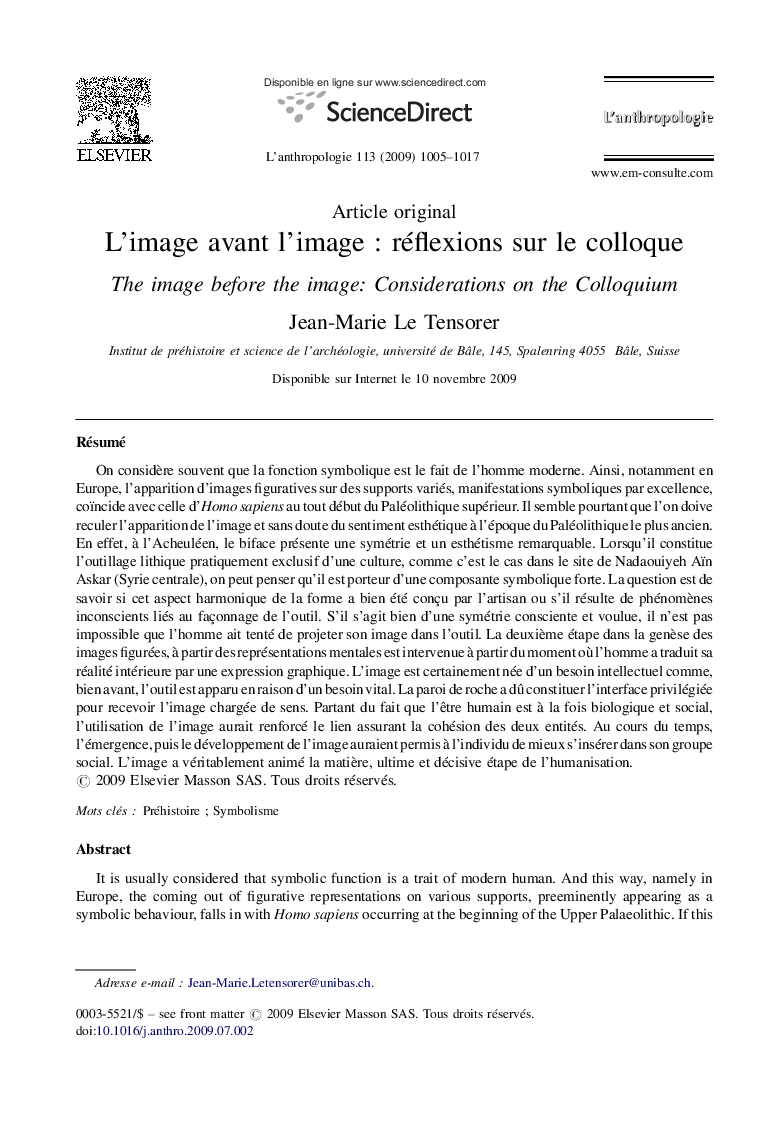| Article ID | Journal | Published Year | Pages | File Type |
|---|---|---|---|---|
| 1033759 | L'Anthropologie | 2009 | 13 Pages |
RésuméOn considère souvent que la fonction symbolique est le fait de l’homme moderne. Ainsi, notamment en Europe, l’apparition d’images figuratives sur des supports variés, manifestations symboliques par excellence, coïncide avec celle d’Homo sapiens au tout début du Paléolithique supérieur. Il semble pourtant que l’on doive reculer l’apparition de l’image et sans doute du sentiment esthétique à l’époque du Paléolithique le plus ancien. En effet, à l’Acheuléen, le biface présente une symétrie et un esthétisme remarquable. Lorsqu’il constitue l’outillage lithique pratiquement exclusif d’une culture, comme c’est le cas dans le site de Nadaouiyeh Aïn Askar (Syrie centrale), on peut penser qu’il est porteur d’une composante symbolique forte. La question est de savoir si cet aspect harmonique de la forme a bien été conçu par l’artisan ou s’il résulte de phénomènes inconscients liés au façonnage de l’outil. S’il s’agit bien d’une symétrie consciente et voulue, il n’est pas impossible que l’homme ait tenté de projeter son image dans l’outil. La deuxième étape dans la genèse des images figurées, à partir des représentations mentales est intervenue à partir du moment où l’homme a traduit sa réalité intérieure par une expression graphique. L’image est certainement née d’un besoin intellectuel comme, bien avant, l’outil est apparu en raison d’un besoin vital. La paroi de roche a dû constituer l’interface privilégiée pour recevoir l’image chargée de sens. Partant du fait que l’être humain est à la fois biologique et social, l’utilisation de l’image aurait renforcé le lien assurant la cohésion des deux entités. Au cours du temps, l’émergence, puis le développement de l’image auraient permis à l’individu de mieux s’insérer dans son groupe social. L’image a véritablement animé la matière, ultime et décisive étape de l’humanisation.
It is usually considered that symbolic function is a trait of modern human. And this way, namely in Europe, the coming out of figurative representations on various supports, preeminently appearing as a symbolic behaviour, falls in with Homo sapiens occurring at the beginning of the Upper Palaeolithic. If this fact seems well established, however it looks likely that the emergence of image and aesthetic feeling has to be dated back to the Lower Palaeolithic. Indeed, the Acheulean biface shows a morphological symmetry and a remarkable aesthetic. Whenever this tool exclusively constitutes the lithic assemblage of a culture, as it is the case in the site of Nadaouiyeh Aïn Askar (central Syria), it can be suggested that it conveys a strong symbolic power. The question is, was this harmonic aspect of the shape really conceived by the tool maker or does it result from an unconscious phenomenon related to the knapping of the artefact? If it is indeed a conscious and desired symmetry, it is not impossible that the artisan tried to project his own image into the tool. The second stage during the genesis of figurative pictures issuing from mental images appears as Human turned his inner reality into graphic expression. Pictures most certainly were born from a surge of intellectual need just as tools had appeared, long before, to meet vital necessities. The rock surface may have stood for a privileged interface for accepting an image full of signification. Starting from the fact that Man is both a biological and a social being, the use of pictures might have worked as a means of reinforcing the cohesion of the two entities. In the course of time, figurative images as they appeared and developed, might have enabled the individual to better fit into his social group. Image has truly been giving life to matter and substance, the ultimate and crucial stage of humanisation.
